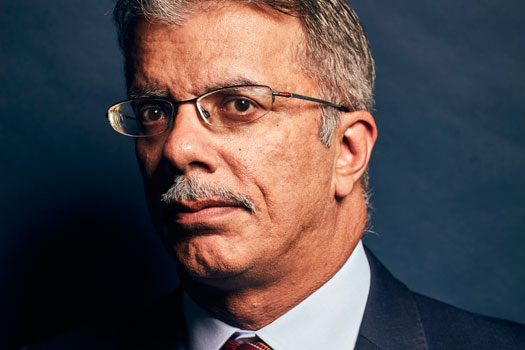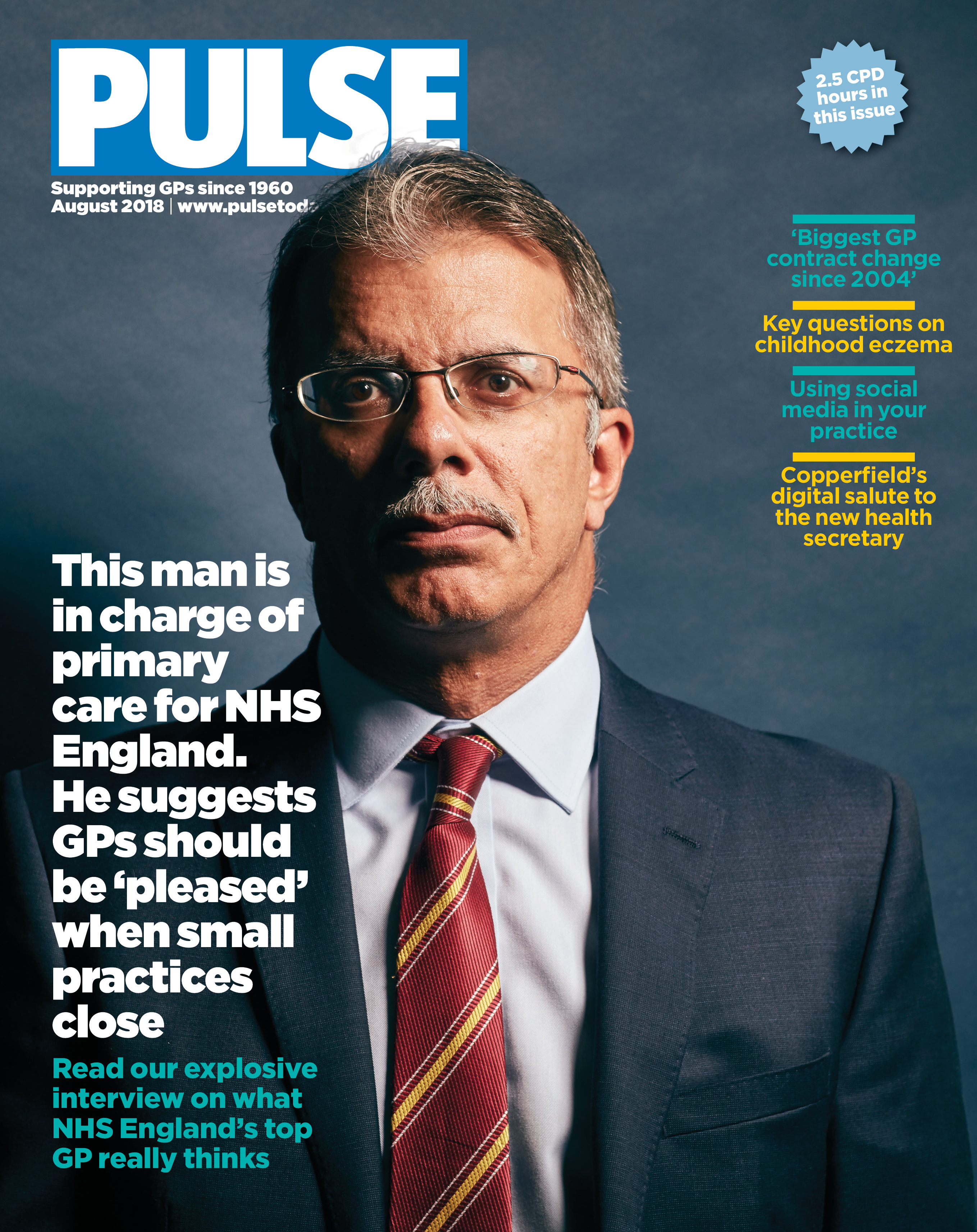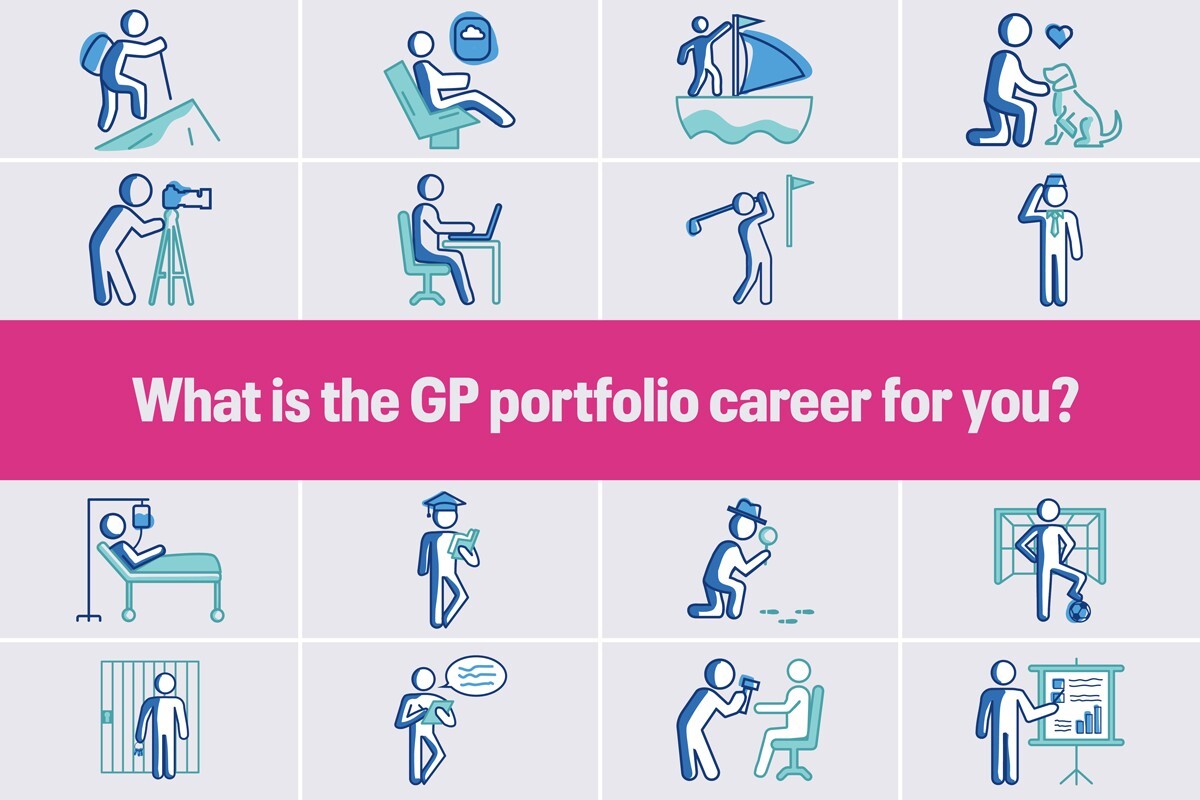What NHS England’s top GP really thinks


pulse cover aug 18
Grassroots GPs have long been derided for believing NHS England is comfortable with small practices closing.
But Pulse’s explosive interview with NHS England director of primary care Dr Arvind Madan reveals they might have a point.
Pulse interviewed Dr Madan at the NHS England headquarters in London, accompanied by the national director of commissioning, Dom Hardy, following comments attributed to Dr Madan that said: ‘Most businesses are pleased to see a rationalisation of providers, as it makes the remainder more viable. In the general practice market, there are too many small practices struggling to do everything patients now want for their families in a modern era of general practice.’
Dr Madan stands by these comments, as well as his assertion that practices must take part of the blame for failure to recruit.
There are too many small practices struggling to do everything patients now want for their families in a modern era of general practice
Dr Arvind Madan
There is a streak of thinking running through this. It’s the belief that general practice has to move towards modern, efficient businesses – specifically in larger groupings – where the practices that thrive reap the rewards. Those unwilling or unable to transform are left – as one former NHS England medical director put it – to ‘fail and wither’.
This means working at scale, embracing technology, entrepreneurialism and innovative staffing.
But GP leaders have pointed out this ignores the reality that some practices are simply unable to transform or upscale. Their location may prevent this or they may have tried to do so and failed. In many cases, though, they are so consumed by simply keeping their heads above water that they don’t have the time or headspace to think about it.
Furthermore, these GPs point out that small practices are popular with patients, who value their continuity of care.
He stood by these comments and explained: ‘General practice here is built on a foundation of 7,400 small and medium-sized businesses. In all markets, there is some degree of difficulty for a proportion. The environment is a big factor within that. But actually, I think we would all like modern, thriving general practice available to us and our families.’
These comments bring to mind those made by Paul Twomey, medical director of the Yorkshire and Humber NHS England area team in 2016, who sent an email to practices saying vulnerable practices must ‘transform…or be allowed to fail and wither’. The comments – unveiled by Pulse – made the BBC 10 O’clock News and NHS England immediately denied this was national policy at the time.
But Dr Madan’s comments seem to suggest that, in NHS England’s thinking, there are ‘too many’ small practices.
He is clear on his vision, pointing to the rollout of between ‘1,000 and 1,500 primary care networks, covering 30,000-50,000 patients’, saying grassroots GPs should embrace this (see box).
But what about those that don’t transform? He says: ‘I think it is our job to help every practice on this journey. There is a degree to which the central national team can create the environment in which all practices can thrive. But there is also a degree of responsibility within practices, which I am sure they will accept, to take up the opportunity because I am not clear that passively waiting for the system to change around them is sufficient.’
NHS England has pointed to the support it has given smaller practices to transform and stay afloat. It is spending £50m on the ‘vulnerable practices’ and ‘practice resilience’ funds, and that its Estates and Technology Transformation Fund (ETTF) has helped 1,670 schemes as of March 2018.
Partners actively decide between profits and access
Dr Arvind Madan
Yet managers admit they have struggled to tackle the biggest crisis engulfing general practice – recruitment. ‘We are clearly challenged on GP numbers,’ says Dr Madan.
The figures bear this out. England has lost more than 1,000 full-time-equivalent GPs since September 2015, when former health secretary Jeremy Hunt set his target of 5,000 extra GPs by 2020.
Comments attributed to Dr Madan suggest he believes GP partners make a trade-off between access and income, and better organised practices get the staff.
Again, he stands by this and explains: ‘In the era of undersupply, it is the case that the environment in which practices are looking to recruit is not easy. Clearly there are elements that are within our control. People are looking for different ways of working, they are looking for more flexibility. They are looking for more family-friendly balance in their work/leisure ratio. We need to respond to this.’
He points to NHS England’s efforts to increase GP numbers through the international recruitment scheme, the induction and refreshers programme and incentives for older GPs to stay on. But he adds: ‘Equally there are lots of factors within the control of individual practices around how much pay, how much flexibility and how much individuals are made to feel part of a team with a purpose.’
Yet there aren’t enough GPs out there, and in some areas, such as Plymouth, it is impossible to recruit, regardless of how well organised practices are.
Dr Madan concedes: ‘It is a real challenge, and Plymouth is one of those situations we are watching very carefully.’
However, he returns to primary care networks, saying they can ‘give GPs opportunities to work with a more diversified team, developing specialist areas of interest, working across groups of practices, which may focus on areas they have an interest in and trying to build up that broader proposition of a wider team of clinicians’.
But GP leaders approached by Pulse after the interview were not convinced by these visions of the future. Indeed, they expressed outrage at the comments, but say they have long suspected this is the view of NHS England officials behind the scenes.
Dr Zoe Norris, chair of the BMA’s GP sessionals subcommittee, says: ‘I’m surprised and disappointed. I would have more respect for NHS England if they were upfront about their agenda.
‘Many GPs have felt for a long time that there is only one direction of travel being pushed by NHS England: away from small practices and into groupings of a defined size as primary care networks.’
There are real concerns around the assumptions behind Dr Madan’s comments. Dr Rachel McMahon, England Conference of LMCs chair, says many practices are simply unable to transform. Pulse’s recent ‘Postcards from the Edge’ feature (pulsetoday.co.uk/postcards) highlighted that in areas such as Plymouth and Brighton, practices across a whole town are struggling to survive.
She adds: ‘To suggest practices in these areas have the headspace available to drive forward major transformation when all their efforts are going into just keeping the doors open seems naive to the issues these GPs are facing.’
And transformation in such areas is not cheap. As Pulse has reported, Bridlington – whose practices have all applied to close their lists – was promised a £10.8m ‘health and wellbeing centre’ through the ETTF in 2016. But when costs escalated, the CCG pulled the plug on the funding.
Patient satisfaction
But, perhaps more importantly, there seems to be a lack of governmental faith in what small practices bring to general practice.
As Dr McMahon puts it: ‘I am in the privileged position of being able to speak directly to patients at a variety of practices. My personal opinion is that the highest levels of patient satisfaction seem to be from patients who are registered with smaller practices, as they are able to experience a more personalised service.’
There is also an underlying principle here – do we want to see a ‘marketisation’ of general practice? As Londonwide LMCs chief executive Dr Michelle Drage says: ‘For general practice to do “everything you would want for your family” it shouldn’t be placed in a market. Market success or failure should not be the measure by which we judge it.’
This may not be a view shared in the corridors of power.
What are ‘primary care networks’?
There is no real definition of a primary care network that NHS England is promoting. They emphasise the networks are built from the bottom up, so they will differ.
However, they do have certain characteristics in common:
• They cover a patient population of at least 30,000-50,000.
• The GPs head up ‘multidisciplinary teams’, formed of nurses, mental health workers, and clinical pharmacy teams.
• There are expanded diagnostic facilities.
• They pool responsibility for urgent care and extended access.
Dr Arvind Madan suggests the networks comprise around ‘100-150 clinicians’.
NHS England says this model ‘does not require practice mergers or closures, or necessarily depend on physical co-location of services’.
It includes federations, ‘super-surgeries’, primary care homes, and ‘multispecialty community providers’.
NHS England is incentivising practices to join primary care networks through funds for extra staff and premises.
Pulse reported that in Essex, CCGs have stumped up £35m for practices to work ‘at scale’ by ‘significantly increasing investment in workforce, estate and digital solutions’.
Portfolio careers
What is the right portfolio career for you?














